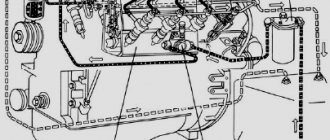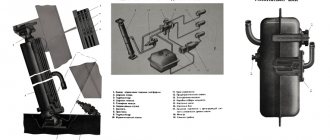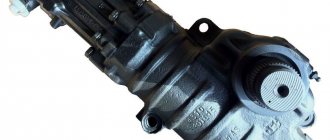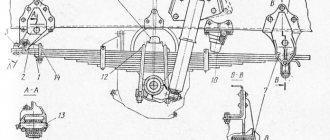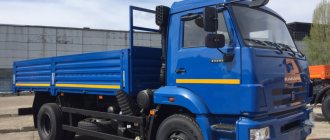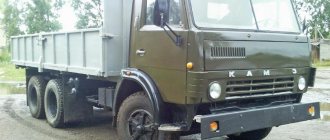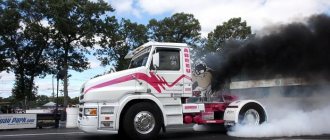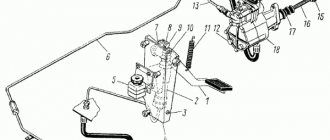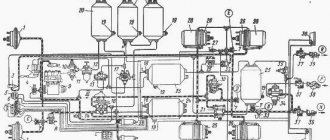The injector is designed to inject a certain amount of finely atomized fuel into the combustion chamber. KamAZ 740 diesel engines use closed-type injectors with a fixed nozzle and hydraulically controlled needle.
The injector nozzle of the KamAZ-740 engine has four nozzle holes, the nozzles are adjusted to a nozzle needle lifting pressure of 180 + 0.5 MPa. The Kamaz-740 injector is installed in the cylinder head and secured with a bracket. The end of the nozzle nut is sealed against gas breakthrough with a corrugated washer.
The turbocharged Kamaz-740 engine has a model 271 injector with increased fuel throughput and a nozzle hole diameter of 0.32 mm.
Sprayer
. Nozzle mod. 273-31 for the KamAZ 740.11-240 engine. Maud. 273-21 with YAZDA sprayer or mod. 273-51 with Bosch nozzle for engines 740.13-260 and 740.14-300. On the 740.11-240 engine it is allowed to install injectors mod. 273-21 and 273-51 used on engines 740.13.-260 and 740.14-300.
YAZDA injectors
The wide range of injectors produced by YaZDA OJSC allows YaMZ, KamAZ, MMZ, TMZ engines to have high economic, power and environmental indicators, including those that meet Euro-3, Euro-2 standards.
The modern design of nozzles ensures stable performance and ease of maintenance.
Nozzles with installation diameters of 25, 24, 22.5 mm are serially produced. The plant's capabilities allow us to produce nozzles with an installation diameter of 17 and 21 mm for automobile, tractor and stationary diesel engines.
Currently, work is underway to create injectors that provide multi-phase and multi-stage fuel injection, having both mechanical and electronic control.
Checking and adjusting the KAMAZ 740 injector
The injector is checked by three parameters
:
1
.
This is the pressure at which the spray needle 2
.
This is the hydraulic density of the sprayer 3
. This is the quality of fuel atomization
1
.
Place the nozzle on the test stand. 2
.
Check the needle lift pressure and adjust the pressure if necessary. The pressure at which the needle begins to rise
should be 18.0+0.5 MPa (180+5 kgf/cm2).
The nozzle is adjusted by changing the overall thickness of the adjusting washers 10
installed under the spring
12
.
When the total thickness of the adjusting washers increases (increasing spring compression), the pressure increases; when it decreases, it decreases. A change in the thickness of the washers by 0.05 mm leads to a change in the pressure at which the nozzle needle begins to rise by 0.3-0.35 MPa (3-3.5 kgf/cm2). To adjust the nozzle, it is necessary to remove the nozzle from the stand and perform the work of card No. 4. After adjustment, install the nozzle on the stand and check the pressure at which the needle begins to rise. 3
.
Check the tightness of the nozzle shut-off cone. The tightness of the nozzle shut-off cone is determined by the degree of wetting of the nozzle nozzle while maintaining pressure in the nozzle, less than the injection pressure by 0.1 MPa (10 kgf/cm2) for 1 min. If two drops of fuel per minute form and come off the nozzle nozzle, replace the nozzle and send it for repair. The atomizer body and needle form a precision pair in which replacement of any one part is not allowed. When replacing the nozzle, remove the nozzle from the stand and perform work on card No. 4. After replacement, repeat work 1-3 on card No. 5. (Stand, stopwatch). 4
. Check the quality of fuel atomization. The quality of atomization is considered satisfactory if, when supplying fuel to the nozzle with 70-80 swings of the pump lever per minute, it is injected in a mist-like state, without droplets, with a uniform outlet across the cross section of the jet cone from each atomizer hole. The beginning and end of the injection cutoff must be clear. Fuel injection with a new injector is accompanied by a sharp sound, the absence of which in a used injector is not a sign of poor quality work. If one or more holes become coked, disassemble the nozzle, clean the holes and rinse with gasoline. If fuel leaks along the cone or the needle is stuck, replace the precision needle-nozzle body pair. The atomizer body and needle form a precision pair in which replacement of any one part is not allowed. (Stand, stopwatch).
Poor and good spray
5
. Remove the injector from the test stand by disconnecting the fuel lines from the injector.
Repair, adjustment, replacement of nozzles of all types of mechanical injectors. Within 1 hour!
Heavy smoke and high fuel consumption are the signals that the car owner should pay attention to; they will tell him that it is time to change the injectors in the car’s diesel engine. True, they do not always need to be completely changed; often they can simply be repaired.
The most common causes of injector failure
Common causes of failure include wear, clogging or corrosion. If you have never repaired diesel engine injectors, then it is best to entrust this complex work to the specialists of our car service center. All spare parts are in stock.
Cost of repairing mechanical diesel injectors:
| Name | Applicability | * Cost of work including replacement of spare parts from | Cost of work | Maintenance and Adjustment | Diagnostics |
| 33; 271 | KAMAZ | 400/450 | 250 | 250 | 50 |
| 273-31 | KAMAZ Euro | 400/450 |
Cost of services including VAT (RUB)
*Major overhaul – complete replacement of precision parts (multipliers, valves, rods, nozzles).
The injectors of a diesel engine, as well as an injection engine, periodically become dirty. Therefore, many owners of cars with a diesel engine are wondering - how to check the injectors on a diesel engine? As a rule, if they are clogged, fuel is not supplied to the cylinders in a timely manner, and increased fuel consumption occurs, as well as overheating and destruction of the piston. In addition, burnout of the valves and failure of the particulate filter are possible.
Diesel engine injectors
Checking KAMAZ engine injectors
The injectors are used to atomize and uniformly supply fuel to the cylinders. KAMAZ engine injectors are closed type; Fuel from the high-pressure pump through the filter and channel 13 enters the annular cavity 14, presses on the conical surface of the needle 2 and, at a pressure of 145-155 kg/cm2, lifts the needle and is injected into the combustion chamber through the nozzle holes. At the cut-off moment, when the pressure drops sharply, the spring 7 through rod 5 quickly lowers the needle down. The tension of spring 7 is adjusted by screw 8.
nozzle
Why does it protect you from bullies?
You probably guessed it yourself.
- Excessive temperature is removed from the piston.
- This means that there is no excessive thermal expansion of the piston and rings (compression and oil scraper)
- Better lubrication of the cylinder (after all, oil is sprayed not only on the piston bottom, but also on the walls). And this means better glide, it also gives resource
Now let's watch the video version of the article.
This is where I end my materials, I think they were useful to you. Write comments, subscribe to the YOUTUBE channel, sincerely yours, AUTOBLOGGER
(
15 votes, average: 4.47 out of 5)
Similar news
Is it necessary to warm up the engine? Before the trip? Let's analyze winter and summer.
Where is the oil filter located? And why is it needed?
Proper cleaning of spark plugs. At home, with your own.
Add a comment Cancel reply
The principle of operation of the nozzle
The injection pump supplies the injectors of each cylinder with strictly dosed fuel under high pressure in accordance with the operating procedure and the specified mode. The nozzle is used to spray fuel in accordance with the shape of the combustion chamber.
Under a pressure of 18-20 MPa, fuel enters the needle and lifts it from the seat. The fuel passes through the nozzle and enters the cylinders in the form of mist. When the spring is compressed, the needle sits in its seat and some of the fuel is pushed out through the discharge channel through the valve and goes into the return line.
Three types of engine cooling
If you take an internal combustion engine (be it diesel or gasoline ), its design, to put it mildly, is not ideal! I have already written that the efficiency of a gasoline unit is only 20–25% , a diesel unit is 40–50% (which is better, but also far from ideal). And most of the fuel, to put it exaggeratedly, is converted into heat (heat losses), in gasoline versions they can reach up to 35%! And this is a lot.
But that's not the point. To prevent our engine from simply overheating and jamming, we need effective cooling. Moreover, we mainly need to cool the so-called piston group and timing system (after all, the main temperature is there).
What cooling systems do we know:
Personally, that's what I call her. The metal that makes up the block can be made massive, with ribs, for effective heat dissipation. The material can be cast iron or, say, aluminum, pistons and rings (compression and oil scraper) can be made massive (like connecting rods, crankshaft, etc.) - they perfectly transfer temperature to the block. The combustion chamber is not so voluminous, and such an engine will cool itself - say, when moving. Air flows will pass through the “ribs” cooling the structure. Probably everyone remembers ZAZ cars (in common parlance “Zaporozhets”), and so, it was cooled using the air method.
PROS: There is no unnecessary equipment that takes power from the engine - such as a pump. There are also no radiators, antifreeze (antifreeze), thermostat, etc. Which extremely simplifies the design of both the motor and the cooling system
CONS: Nowadays this system is practically not found. All due to the fact that there is really not enough of it in the hot months, the engine simply overheats. There is also no liquid heating in winter, which is extremely inconvenient! This design is now found only on mopeds, motorcycles and some agricultural equipment.
ACTIVE (or forced)
As you guessed, this system is a modern car. In simple words, a large number of channels pass through the block head and the block itself, in which coolant ( antifreeze or antifreeze ) circulates. It is she who removes heat and, with the help of radiators, dissipates it into the environment. The system is pumped by a pump, a special pump that is often powered (via a belt drive) from the crankshaft, although now electric systems (where the pump has an electric motor) are increasingly appearing.
The ADVANTAGES of this system include sufficient lightening, that is, massive blocks, pistons, crankshafts, etc. are no longer needed. Everything cools quite well anyway
CONS – I personally call it the abundance of attachments (pumps, antifreeze, etc.). And also the neglect of many manufacturers, who strive to make the engine as light as possible, make tablet pistons and thin rings (although they can no longer effectively remove heat into the walls of the cylinder block). Thoughtless relief leads to a decrease in resource.
But there is another, third type of cooling - with the help of oil, which I want to highlight as a separate item.
Checking the operation of the injector
The injector is checked by three parameters 1. This is the pressure at which the nozzle needle begins to rise 2. This is the hydraulic tightness of the nozzle 3. This is the quality of fuel atomization
device KI - 652
Let's check in detail 1. Parameter: To check the pressure when the needle starts to rise, install the nozzle in the KI-652 device and smoothly apply pressure to the nozzle and look on the scale where it fires. Should be 270 kg/cm.
2. Parameter: To check the hydraulic tightness of the sprayer, it is necessary to apply pressure below the needle lifting pressure, by about 10-15 kg/cm and hold this pressure for 15 seconds. We watch the tip of the sprayer so that fuel does not escape from there. The sprayer must hold pressure.
the spray nozzle
3. Parameter: This is the quality of fuel atomization. It is also checked on the KI-652 device. At intervals of 80 pressure applications per minute and the fuel should be atomized in the form of a mist. The quality of atomization is determined so that fuel is clearly sprayed in the form of a mist from each hole of the 5 atomizer. Jet spraying is not allowed, which means the sprayer must be replaced.
the combustion chamber
Oil cooling
Here you can write for a very long time, but I will try to present everything as compactly as possible (otherwise it will turn out to be a thesis :) )
So, the oil that is in the engine not only has the function of lubrication, protection, washing (washes away impurities and dirt) - IT ALSO COOLS!
In an era when cars were not so revving (30-40 years ago), the pump was not always enough, especially on loaded vehicles (trucks and buses).
There are no revolutions, even while driving, a heavy load of several tons, imperfect oil in the engine (there were no synthetics then) - and it simply burned from high temperatures.
We started to fight this and, as you probably already guessed, we started installing oil cooling radiators . It was placed next to a regular radiator. The oil began to remove temperature from the piston group and also effectively dissipate it.
Disassembling the nozzle
To disassemble it, you need to install it in fixture I 801.20.000 or clamp it in a vice. Use a wrench to unscrew nut 2 securing the sprayer. Remove the housing and remove the sprayer. We take out the spray needle from the body. Remove the nozzle spacer 3. Remove the spring rod and adjusting washers 9-10 from the nozzle. Next, rinse the sprayer and needle in clean diesel fuel. Clean the spray nozzle holes with 0.4 mm wire. The outside of the sprayer can be cleaned of carbon deposits with a wooden block.
device AND 801.20.000.
After washing and cleaning the sprayer, the needle should be checked for tightness. The needle should smoothly fall into place under its own weight.
